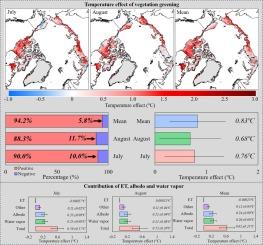Disentangling the contributions of water vapor, albedo and evapotranspiration variations to the temperature effect of vegetation greening over the Arctic
IF 5.9
1区 地球科学
Q1 ENGINEERING, CIVIL
引用次数: 0
Abstract
Vegetation greening is observed over the Arctic, and its feedback to Arctic amplification has attracted increasing attention. Previous studies have primarily focused on the temperature effect of a single environmental variable (e.g., albedo), while the separate contributions of land surface albedo, evapotranspiration (ET) and water vapor remain underexamined. In this study, we develop knowledge-based data-driven models (i.e., path analysis and machine learning) to estimate the temperature effect of vegetation greening and quantify the separate contributions of albedo, ET and water vapor in July and August from 1982 to 2015. The results show a wide range of temperature sensitivity to the NDVI (Normalized Difference Vegetation Index), and vegetation greening has led to Arctic warming of 0.76 °C, 0.68 °C, 0.83 °C in July and August and the average of the two months, respectively. Path analysis suggested that vegetation greening affects Arctic air temperature mainly by regulating albedo and water vapor. In July, changes in water vapor contributed the most to the temperature effect of vegetation greening with a contribution of 0.25 ± 0.08 °C, while in August, changes in albedo and water vapor had similar effects with a contribution of 0.21 ± 0.08 °C. In contrast, changes in ET have generated a negligible cooling effect due to small changes in ET. Further analysis shows similar positive contributions of albedo and water vapor in barren, graminoid tundra, prostrate-shrub tundra and erect-shrub, with contributions ranging from 0.18 ± 0.05°C to 0.30 ± 0.11°C, while changes in water vapor dominate vegetation’s temperature effect in wetlands, with contributions ranging from 0.26 ± 0.11°C to 0.32 ± 0.16°C. This study emphasizes the importance of considering multiple driving factors to assess the temperature effect of vegetation greening in a consistent framework and highlights the critical role of water vapor change in addition to the widely examined albedo in explaining Arctic warming.

厘清水汽、反照率和蒸散量变化对北极植被绿化的温度效应的影响
在北极上空观测到植被变绿,其对北极变暖的反馈作用已引起越来越多的关注。以往的研究主要关注单一环境变量(如反照率)对温度的影响,而对陆地表面反照率、蒸散(ET)和水蒸气的单独贡献研究不足。在本研究中,我们开发了基于知识的数据驱动模型(即路径分析和机器学习),以估算植被绿化的温度效应,并量化 1982 年至 2015 年 7 月和 8 月反照率、蒸散发和水汽的单独贡献。结果表明,温度对归一化差异植被指数(NDVI)的敏感性范围很广,植被绿化导致北极7月和8月升温0.76 ℃,0.68 ℃,0.83 ℃,这两个月的平均值也分别升温0.76 ℃、0.68 ℃和0.83 ℃。路径分析表明,植被绿化主要通过调节反照率和水汽来影响北极气温。在 7 月份,水蒸气的变化对植被绿化的气温效应贡献最大,为 0.25 ± 0.08 °C;在 8 月份,反照率和水蒸气的变化具有相似的效应,贡献为 0.21 ± 0.08 °C。相比之下,由于蒸散发的微小变化,产生的降温效应可以忽略不计。进一步的分析表明,反照率和水汽在贫瘠苔原、禾本科苔原、匍匐灌木苔原和直立灌木中具有类似的正贡献,贡献范围从 0.18 ± 0.05°C 到 0.30 ± 0.11°C,而水汽的变化在湿地植被的温度效应中占主导地位,贡献范围从 0.26 ± 0.11°C 到 0.32 ± 0.16°C。这项研究强调了考虑多种驱动因素的重要性,以便在一个一致的框架内评估植被绿化的温度效应,并突出了除广泛研究的反照率外,水汽变化在解释北极变暖中的关键作用。
本文章由计算机程序翻译,如有差异,请以英文原文为准。
求助全文
约1分钟内获得全文
求助全文
来源期刊

Journal of Hydrology
地学-地球科学综合
CiteScore
11.00
自引率
12.50%
发文量
1309
审稿时长
7.5 months
期刊介绍:
The Journal of Hydrology publishes original research papers and comprehensive reviews in all the subfields of the hydrological sciences including water based management and policy issues that impact on economics and society. These comprise, but are not limited to the physical, chemical, biogeochemical, stochastic and systems aspects of surface and groundwater hydrology, hydrometeorology and hydrogeology. Relevant topics incorporating the insights and methodologies of disciplines such as climatology, water resource systems, hydraulics, agrohydrology, geomorphology, soil science, instrumentation and remote sensing, civil and environmental engineering are included. Social science perspectives on hydrological problems such as resource and ecological economics, environmental sociology, psychology and behavioural science, management and policy analysis are also invited. Multi-and interdisciplinary analyses of hydrological problems are within scope. The science published in the Journal of Hydrology is relevant to catchment scales rather than exclusively to a local scale or site.
 求助内容:
求助内容: 应助结果提醒方式:
应助结果提醒方式:


